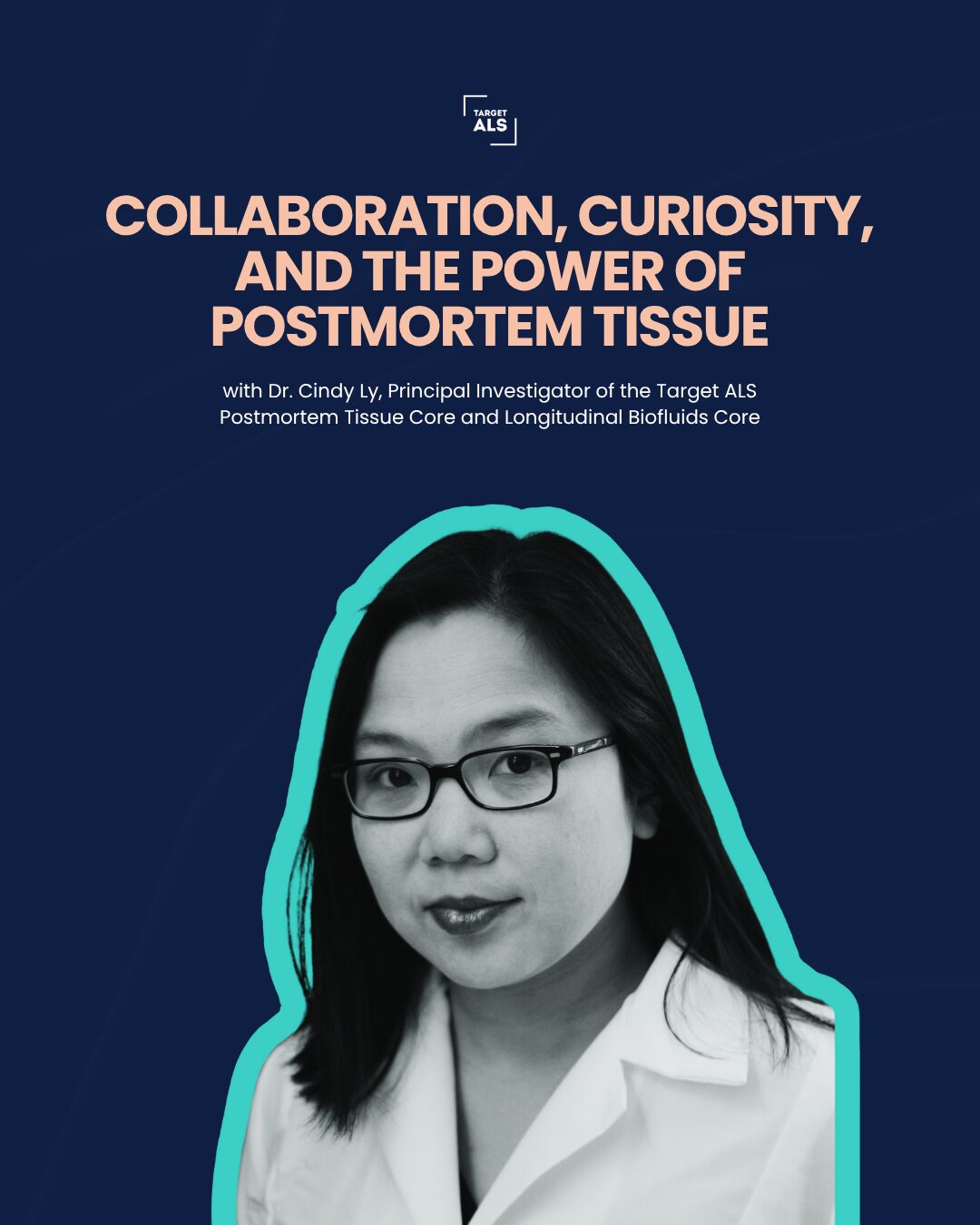About the Engine
In March 2024, Target ALS, launched a revolutionary data engine designed to accelerate breakthroughs in biomarker and drug discovery for ALS. The data engine, created in collaboration with DNAstack and Verily, hosts comprehensive datasets from human samples and offers unprecedented no-strings-attached access to researchers worldwide. By providing a centralized hub for large, multi-omic datasets, the Target ALS Data Engine aims to foster collaboration and fuel discovery of reliable biomarkers and effective treatments for ALS.
Through the engine, researchers can access well-characterized data collections from Target ALS’ Scientific Core Facilities, including the Postmortem Tissue Core, Longitudinal Biofluids Core (Natural History Study), and Stem Cell Core. Multi-omic data sets can be mined to identify novel pathological and genetic risk factors, biomarkers, and therapeutic targets for both sporadic and genetic forms of ALS. True to Target ALS’s mission of breaking down barriers to ALS research, the engine empowers scientists globally by providing free access to data, while researchers retain full rights to any intellectual property stemming from their discoveries. Information on storage, compute, and data management fees is available on the engine, ensuring transparency and ease of use in this collaborative environment.
New on the Engine
The Target ALS Data Engine contains new raw data in each collection, which is uploaded every 4-6 months, as well as a new curated dataset in the Postmortem Tissue Collection. Read on to learn about the comprehensive datasets available on the engine.
Additionally, a user manual and new demo videos have been added to each collection, helping users navigate and utilize the platform more effectively.
Postmortem Tissue Core
The Target ALS Postmortem Tissue Core is dedicated to speeding up the development of ALS therapies by providing high-quality human postmortem tissue and comprehensive datasets to researchers worldwide. This valuable resource supports both academic and industry researchers in their quest to improve our understanding of ALS and develop effective treatments.
Available Datasets
- Histopathology Images from 100 ALS cases stained for pTDP43
- Semi Quantitative TDP43 data
- New Whole Genome Sequencing (WGS) from ALS and FTLD cases
- New Bulk Tissue RNA Sequencing (RNA-Seq) from ALS and FTLD cases
- New Spatial Transcriptomics from multiple sections of motor cortex. Stay tuned for large data upload in Q4.
- Spatial RNA-Seq
- Histopathology Images
- Columbia Spatial RNAseq Metadata
- New RNAseq counts, already processed from BAM files to save you time
Researchers should note that multimodal datasets exist for many cases, but there are instances where not all data types exist for a given patient.
For more information and to access the data, visit the Post-Mortem Tissue Core Collection.
Tissue Samples
The Postmortem Tissue Core biobank holds frozen and formalin-fixed paraffin-embedded (FFPE) tissue from 300 ALS patients and 50 control cases. Over the past decade, the core has provided samples to over 300 laboratories, facilitating hundreds of research projects, and banked over 50,000 brain and spinal cord tissue samples at five geographically distributed sites across the USA. To request tissue samples, click here.
Natural History Study
The Target ALS Natural History Study aims to create the most comprehensive collection of biosamples and datasets for ALS biomarker discovery and research. Actively recruiting 800 ALS patients and 200 healthy controls, this international, multi-site study is expanding our understanding of ALS across genetically and ethnically diverse populations.
Study Expansion and Collaboration
- Global Reach: Initially conducted at 6 sites, the study has now expanded to 13 sites across the USA, South America, and Israel. This expansion aims to address gaps in data from diverse populations worldwide.
- Expert Contributions: Clinical data is collected by leading neurologists from top ALS clinics, while multi-omic data is provided by renowned institutions such as the New York Genome Center (NYGC), the Broad Institute, and the University of Gothenburg.
Available Data
- New De-Identified Clinical and Demographic Information from 125 participants
- New Genome Sequencing Files and Metadata from 72 participants
- New Longitudinal Speech Data from the Aural Analytics platform
- New Longitudinal Measures of Respiratory Function from Zephyrx platform
Datasets from each tab can be linked by Patient ID, allowing researchers to integrate data across different categories for a more comprehensive analysis. The study has already enrolled more than 100 participants, and the data is actively updated as more participants complete the study.
Future Data Availability
- Additional Longitudinal, Multi-Omic Datasets
- Neurofilament Light Analyses
Researchers should note that there may be instances where not all data types or time points exist for every patient. However, the available data still represents an invaluable resource for ALS research and therapy development.
For more information, visit the Natural History Study Collection.
Stem Cell Core
The Target ALS Stem Cell Core is a network of contract research organizations and academic core facilities dedicated to advancing our understanding of ALS. This network generates and distributes patient-derived stem cell lines, along with associated data, to help researchers investigate the underlying mechanisms of ALS and assess the effects of potential drugs on disease pathology.
Available Data:
- Stem Cell Lines: The core provides stem cell lines derived from both healthy individuals and ALS patients, including those with sporadic or familial forms of the disease. These lines cover key ALS-related mutations such as C9orf72, SOD1, and TDP43.
- Whole Genome Sequencing (WGS):WGS data for each stem cell line, available on the enginel, offers insights into the genetic makeup of these lines.
- RNA Sequencing (RNAseq): For a subset of the lines, RNAseq data is also available, providing detailed information on gene expression.
Future Data:
- In 2025, the collection will expand to include new patient lines with matching isogenic control lines. Data from these new iPSC lines, including WGS, RNAseq, and proteomics, will be made available for analysis.
For more information, visit the Stem Cell Core Collection.
Empowering Researchers with Critical Data Resources
The Target ALS data engine is powered by DNAstack’s Omics AI software suite. Omics AI provides researchers a new way of unveiling discoveries while simultaneously making it easier for data stewards to improve the accessibility of their datasets. Instead of following the traditional model of “data sharing”, the Omics AI-powered data enginel follows a new paradigm of “data federation” where researchers keep their data in place, and allow for questions to be queried across a network of data. This approach is faster, more secure, and compliant with open standards, while also empowering data contributors to retain sovereignty, control, and measure impact of their data.
Verily Workbench is a collaborative research environment for governing and analyzing global multimodal biomedical data. Target ALS uses Verily Workbench for secure access and analysis of multimodal ALS data, in order to advance understanding of the disease and accelerate treatments.
Join the Fight Against ALS
We invite researchers, clinicians, and the broader scientific community to explore the Target ALS Data Engine and leverage its resources to advance ALS research. Together, we can uncover the mysteries of ALS and pave the way for breakthroughs that will change the lives of those affected by this devastating disease.
For more information and to access the datasets, visit the Target ALS Data Engine.
Stay connected with Target ALS for the latest updates on our research initiatives and community efforts by signing up for our newsletter here.
About Target ALS
Target ALS is a 501(c)(3) medical research foundation focused on breaking down barriers to Amyotrophic Lateral Sclerosis (ALS) research to find effective treatments and realize a world where Everyone Lives. Founded in 2013 by former New York City deputy mayor Dan Doctoroff — who lost both his father and uncle to ALS and was himself diagnosed in 2021 – Target ALS has transformed ALS research through their landmark Innovation Ecosystem model. The organization has fostered unprecedented collaborations between academia and the pharma and biotech industry, lowered barriers to access for critical research tools, and become a hub of communication and networking for the worldwide scientific community, resulting in the launch of 7 clinical trials and dozens of drug discovery programs over the last decade. For more information and to get involved, visit www.targetals.org
About DNAstack
DNAstack is a Canadian company whose mission is to save and improve lives by unlocking the collective power of the world’s genomics and health data. Omics AI is a software suite by DNAstack that enables privacy-preserving federated insights across distributed data. DNAstack is a global leader in the development of open, interoperable standards as part of the Global Alliance for Genomics & Health (GA4GH).
About Verily
Verily is an Alphabet health technology company focused on research, care, and health financing to deliver on the promise of precision health and help people live healthier lives. We are uniquely positioned at the intersection of technology, data science, and healthcare to create tools to accelerate evidence generation, products to enable more personalized care, and approaches to make costs more predictable. For more information about Verily please visit verily.com or reach out to learn more about how Viewpoint Workbench can accelerate research.





